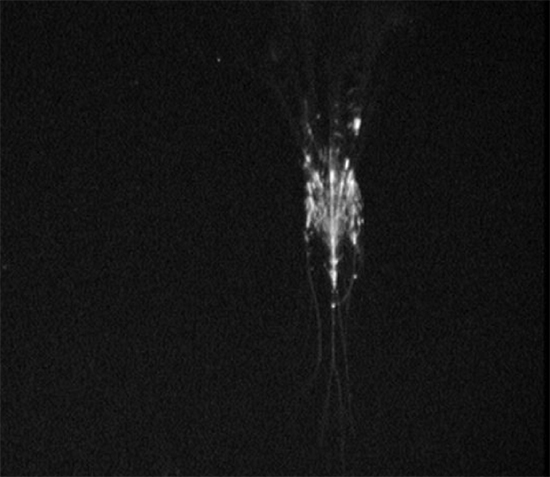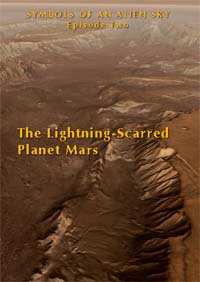|

Cosmic rays could be generated in
the same way as high-altitude
"sprites" create positive ions.
Credit: Oscar van der Velde
Cosmic Accelerator
Mar 07, 2011
New observations suggest that
cosmic rays are not produced by
supernova explosions.
Cosmic rays are ionized
particles, or fragmented atoms.
Electrons are stripped from atoms,
leaving them free to move, with
positively charged nuclei remaining.
The majority of cosmic rays are
single protons (hydrogen ions), but
uranium and other massive ions have
also been detected.
As standard theory states, ions
are accelerated to velocities
approaching the speed of light by
unknown forces, although published
research in 2009
identified exploding stars as the
best candidate. Most cosmic rays are
at energy levels below one billion
electron volts, so when
they hit atoms in Earth's atmosphere
they initiate small secondary
showers of particles and are
absorbed before they reach the
ground.
In June 2006, the Payload for
Antimatter Matter Exploration and
Light-nuclei Astrophysics (PAMELA)
payload was launched onboard a
Resurs-DK1 Russian satellite as part
of the Russian-Italian Mission (RIM)
research program. PAMELA's primary
goal, in conjunction with the
Astrorivelatore Gamma ad Immagini
ultra LEggero (AGILE) and Fermi
Gamma Ray Space Telescopes (formerly
GLAST) is to study the properties of
high energy signals from deep space.
According to a recent
press release, PAMELA has
discovered radiant emissions that
seem to contradict the conventional
explanation for cosmic rays in deep
space. New observations by its
cosmic ray detector prompted
astronomer Piergiorgio Picozza of
Italy's National Institute of
Nuclear Physics and the University
of Rome to state: "Now we don’t know
how cosmic rays are accelerated in
space. Before our data, it seems
that the paradigm is supernova
remnants. Now we have to think of
some refinement of this paradigm, or
we need to find some other
possibility."
Although exploding stars
(supernovae) are misapprehended to
be kinetic events involving shock
waves and rebound phenomena,
interpreting them as the points
where cosmic Birkeland currents
create "z-pinch" vortices brings
everything into focus. Magnetic
fields have been detected in space.
Those fields are thought to be
generated by electric currents
flowing through and around galaxies
along light-years long "transmission
lines" called Birkeland current
filaments. Magnetic forces constrict
the filaments, twisting them around
each other and forming z-pinch
compression zones. What are called
"double layers" by plasma physicists
form in the stellar circuit.
Nobel prize winner Hannes Alfvén
described a double layer as, "... a
plasma formation by which a
plasma—in the physical meaning of
this word—protects itself from the
environment. It is analogous to a
cell wall by which a plasma—in the
biological meaning of this
word—protects itself from the
environment."
In an Electric Universe, there is
another mechanism for cosmic ray
acceleration and that is the
"exploding" double layer, first
described by Irving Langmuir in
1929. A double layer forms in plasma
when electric current flows through
it.
At times, a double layer might
interrupt current flow in the
circuit, causing a catastrophic rise
in voltage across it. The powerful
energy release of the exploding
double layer is sometimes observed
in power transmission switchyards
when a
circuit breaker is opened
incorrectly.
Electric forces
accelerate charged particles
with energies of 10^20 electron
volts or more. Laboratory
experiments with particle
accelerators confirm the
observation. For mechanical shock
waves to achieve that power would
mean explosive detonations exceeding
the most powerful supernovae ever
recorded.
Stephen Smith
Multimedia

The Lightning-Scarred Planet Mars
Symbols of an Alien Sky
DVD episode 2
A video documentary that could change everything you thought you knew
about ancient times and symbols.
The Symbols of an Alien Sky video series will introduce you to celestial
spectacles and earth-shaking events once remembered around the world.
Archaic symbols of these events still surround us, some as icons of the
world’s great religions, though the origins of the symbols appear to be
lost in
obscurity.
In this second episode of Symbols of an Alien Sky, David
Talbott takes the viewer on an odyssey across the surface of Mars.
Exploring feature after feature of the planet, he finds that only
electric arcs could produce the observed patterns. The high resolution
images reveal massive channels and gouges, great mounds, and crater
chains, none finding an explanation in traditional geology, but all
matching the scars from electric discharge experiments in the
laboratory.
(Approximately 85 minutes) See:
Lightning-Scarred
Planet info
|







